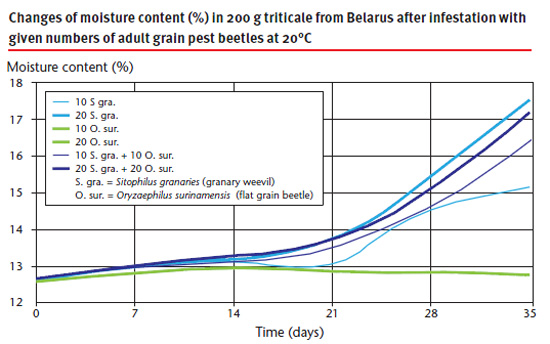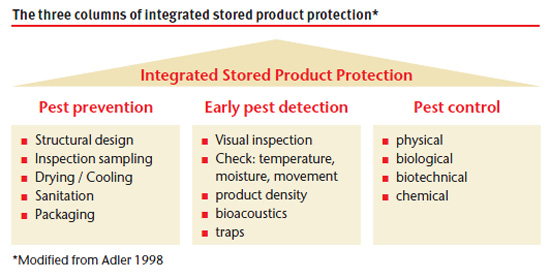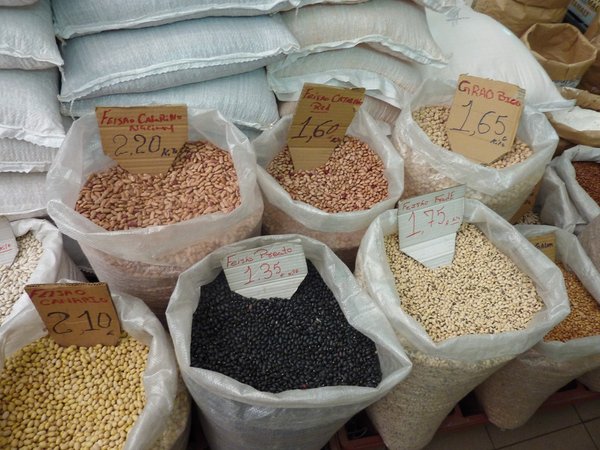 Download this article in magazine layout
Download this article in magazine layout
- Share this article
- Subscribe to our newsletter
New developments in stored product protection
Any plant or agricultural product we produce for human consumption or animal feed will sooner or later be stored in a more or less processed state to be consumed or further processed to a final product. Depending on the water content, we can distinguish perishable products such as fruits or vegetables with a higher moisture content from durables such as grains, pulses, nuts, dried fruits or dried herbs and spices with a low moisture content. Often, the protection of perishables is summarised as post-harvest protection, while the protection of durables is called stored product protection. Usually, products of a higher water content are attacked by fungi and bacteria through a damaged cuticle, such as a cracked tomato skin. Infested plants, stems, roots or fruits should be separated and discarded before the microbial infestation spreads to other products. Perishables may also just lose water and start to shrivel up, or they may start to sprout, as in the case of potatoes.
What are stored product pests?
In durable products, the main pests are insects. These are some 100 species of beetles, moths and dustlice that have become specialised to survive in a comparatively dry environment. Usually, the moisture content in the product is sufficient for stored product insect survival and reproduction. Additional water is produced chemically by respiration, thus breaking down carbohydrates by producing water, energy and carbon dioxide. This is the main reason why heavily infested goods tend to become moist and hot. The Figure shows that within a month, 20 granary weevils in 200 grams of triticale can increase the moisture content to levels where microbial development commences and leads to a rapid deterioration of grain.

Only in extremely arid climates (relative humidity < 35 %) may grain kernels become so hard (e.g. wheat moisture content < 9 %) that not even stored product insects can attack. The latter are also adapted to detect suitable food and oviposition sites by smell, a point that will be discussed later. Even water or spots with increased moisture can be detected by insects.
Vertebrates such as rodents or birds may also feed on stored products. But it is easier to keep these pests away by a good structural design of the storage building because they are much larger and usually need an additional source of water.
Microbial deterioration of durables usually occurs if the product was not sufficiently protected from rain or moisture or after an attack by insects, mites or vertebrates that increased the moisture content. Mites already require higher moisture contents and often occur together with storage fungi. Because many stored product fungi such as the genera Aspergillus and Penicilium are known to produce mycotoxins, a visible microbial infestation generally renders the stored product unsuitable for human or animal consumption. Mycotoxins are the most toxic chemicals known in nature. They are stable to heat and cannot be broken down by cooking or baking. In many tropical and subtropical countries higher incidents of liver cancer and kidney failures can directly be linked to increased human uptake of mycotoxins through infested food, mycotoxin-contaminated meat or beer.
What happens during an attack?
Often, an attack starts with a few individuals or one gravid female arriving at a suitable infestation site. Given suitable stored products and moisture contents as well as temperatures above some 15°C, oviposition will occur. One can distinguish primary pests (e.g. the lesser grain borer Rhyzopertha dominica or weevils of the genus Sitophilus) that can attack a healthy product such as a complete grain kernel from secondary pests that require broken kernels or damage caused by a primary pest (e.g. the flat grain beetle Oryzaephilus surinamensis). The insects break down carbohydrates and produce carbon dioxide, water and energy by respiration. Predators and parasitoids may multiply as soon as they find sufficient numbers of hosts and add to the metabolic production of moisture and heat. Mites and dustlice can multiply in products with increased water content and further accelerate the formation of hot spots with increased temperatures. Frass, faeces and the webbings of moth larvae reduce grain convection and keep moisture and heat in the vicinity. Microbial deterioration starts with xerophilic (draught-tolerant) fungi that also require respiration for metabolism. Only at water activity levels close to 1 and corresponding grain moisture contents above 18 per cent will yeasts grow without the need of oxygen. Gases produced by microbials can form flammable mixtures and ignite spontaneously. But even if no fire occurs, mycotoxins produced in heavily infested grain render the formerly valuable stored product a toxic waste.
Where do the pests come from?
If a pest is found in a package, a storage site or a food factory, it may either have been introduced together with the raw product, it may have been present as part of a residual infestation in machinery or hiding spaces in the building or it may have entered through openings being attracted from outside. This stresses the importance of inspecting the raw product prior to storage, checking the storage structure for a residual infestation (e.g. by heat treatment) and maintaining an insect-proof structural design. To stop the immigration of most beetles, the largest opening in window frames, wire mesh gauzes, package perforations or seals should be not more than 0.5 mm. To prevent neonate larvae of stored product moths, these openings must not be larger than 0.1 mm (Kahn 1982, Adler 2004). Of course, this is quite a challenge and one of the reasons why insects find their way into stored goods so often.
What are reasons for major losses?
In general, a farmer harvesting an agricultural product will try to avoid losses once the harvest is stored. However, certain factors may favour pest attack and losses. For many years the value of grain was extremely low. This is why no one in Central Europe invested in the construction of good grain storage structures for decades. And if grain storage space was desperately needed business assessments dictated the cheapest corrugated metal silo available. This type of silo is common in most parts of the world even though it does not prevent condensation and subsequent moulds or the immigration of insects and is not easily cleaned because of grains getting stuck between metal sheets and not easily sealed for fumigation. But with good weather conditions and sufficient wind, storage in corrugated metal silos may still cause few problems. Only if hot and moist weather conditions occur together with high numbers of flying grain pest insects could major losses occur. Locally, these losses may be higher if a given grain storage remains largely unattended. In Europe, most larger grain storages have thermometer cables to survey the development of a hot spot caused by insect respiration and mould development. Studies are under way to find out if acoustic or optic devices could provide an even better early warning measure at feasible costs.
What is integrated stored product protection?
One can distinguish between preventive methods, monitoring methods to detect pest organisms and control methods (see Figure). Taking into account that product quality always suffers from an attack, all techniques to render a given storage unsuitable for stored product pests should be evaluated. Cool climates, strong or dry winds or the prevalence of aromatic plants may deter stored product insects from a certain area, and knowledge about insect occurrence may help find a suitable site for a new storage.
An insect-proof or hermetic (gas-tight) structural design may be one way to prevent stored product pests from establishing in uninfested goods. This aspect will be discussed later. But keeping dry products such as tubers under a layer of dry sand in earthen pits may be another way to prevent insects.

What is new in stored product protection?
Hermetic storage and packaging. New storage methods provide farmers with hermetic enclosures, such as gas-tight multilayer bags or silobags. A new research project in Germany is to find out if long-term grain storages can be rendered gas-tight at feasible costs and the effect this may have on grain quality at various moisture contents. Since the European ban on dichlorvos (an organophosphorous insecticide) evaporation strips in 2007, conventional grain storages have been facing problems with stored product moths flying into grain storages during warm summer months. This prompts repeated fogging treatments or fumigation in a storage of up to one year but poses a much greater problem to long-term storages. The project is also testing vacuum packaging and low oxygen storage of grain.
Heat treatments for empty structures. Heat treatments with temperatures above some 50°C are used to disinfest empty structures such as silo bins, flour mills, or bakeries in Germany. Usually, some five hours at temperatures above 50°C proved sufficient to control all stages of test insects in heat-treated structures. Metal machine parts or silo bins are usually good conductors of heat. Natural stones and wood show less thermal conductivity, and most energy is required to heat massive concrete structures. However, insects need to be directly exposed to heat, insulators such as grain or flour, dust or packaging material provide good protection and may allow insect survival.
In hot and dry climates, black metal sheets or empty jute sacks could be used for solar heating of air, and with some ventilation this air could be directed into structures or jute sacks, achieving disinfestation at low costs. At temperatures above 60°C, a few seconds are sufficient for complete control. Laboratory experiments were carried out at 45°C, 50°C and 55°C, because at 60°C, the shortest exposure times tested (15 min with Lasioderma serricorne in 10ml of wheat bran) already gave complete control of all stages.
Hot air may also be used to dry grains or control an insect infestation if care is taken not to overheat living seed germs. Otherwise, heat stress may cause levels of germination to drop, indicating other losses in grain quality.
Plant extracts to repel and control pests. In many parts of the world, certain branches, fruits or seeds are traditionally put in between harvested products to repel pests. Numerous scientific studies have been carried out to determine the insecticidal potential of herbs, spices, medical plants and the pure compounds found within these plants. In our lab, we have studied plant extracts since around 1984. Since the early 1990s, we have only supported project applications involving identified and quantified pure compounds. Otherwise, the plant used would be like a black box. An overkill of factors involved in the production and presence of active ingredients such as plant species, soil quality, irrigation, field pest pressure or storage conditions after harvest would render information on efficacy useless.
The pure compounds with pronounced insecticidal properties included anethole, 4-allyl-anisol, camphor, 1,8-cineol, and eugenol, cinnamaldehyde and azadirachtin. Neem oil contains the main active ingredient azadirachtin and has the advantage of being available to farmers in many tropical countries. Our PhD student Katamssadan H. Tofel from Cameroon is studying the effects of various preparation methods on azadirachtin contents and insecticidal efficacy of a self-made product. Of course it is important to consider that repellent or insecticidal compounds may also change the taste or smell of a treated stored product and even be hazardous to the consumer. This is why workers safety and consumer protection aspects must be taken into account when essential oils or insecticidal compounds are purified or used at concentrations higher than naturally available.
Plant extracts to attract pests into traps. One of the astonishing capabilities of stored product insects is their capacity to detect suitable products via olfactory cues. The Indian meal moth Plodia interpunctella was observed placing its eggs directly onto the perforation of a box containing animal feed. Our PhD student Agnès Flore Ndomo from Cameroon is identifying pure compounds from various fruits and nuts that the moth responds to. While moth traps at present use the lure of sexual pheromones which only attract males, food lures, which would also attract females, could be used for mass trapping and pest control.
Diatomaceous earths for pest control. Diatoms are mono-cellular planctonic freshwater and saltwater organisms occurring in huge numbers. They use silica (SiO2) to form intricate skeleton structures. These silicates are amorphous and not crystalline, which is an important factor in workers’ safety. Diatomaceous earth (DE) can be used to filter beer or juices, as inert material in pharmacy to produce pills or in toothpaste, as an abrasive agent on our teeth. Silicate stone layers formed by myriads of diatom skeletons can be found in most regions of the world. These stones can be milled to dust and sieved to a desired particle size. Insects coming into contact with these dusts pick up fine particles on their cuticle, where the dust binds to the wax at the epicuticle and increases the surface, leading to a continuous loss of water. Joints of mouthparts, legs, antennae, and sexual organs are clogged. Desiccation causes insects living in critically dry conditions, like most stored product insects, to succumb within hours up to a few days.
In a project with partners from south-eastern Europe, we found that insecticidal efficacy varies among different proveniences of DE (Athanassiou et al. 2011). Lipophilic DE and small particle sizes were found most effective. Efficacy is much higher at high temperatures, when insects tend to move around faster and desiccate faster. This is why DE research is now also carried out in co-operation with colleagues from Ngaoundere University in Cameroon.
Conclusions
Stored product insects compete with humans when durable goods are to be stored for longer periods. Preventive methods such as insect-proof packaging or hermetic storage structures, cool storage or dry storage conditions together with careful inspection are the most important tools for safe storage. Pest insects should be detected as soon as possible by traps, inspection, temperature surveillance or acoustic methods. Depending on the product and techniques available, physical, biological, biotechnical or chemical means may be used for pest control. Less hazardous methods of control have gained importance lately. Fumigants and physical control techniques have replaced contact insecticides, and low-oxygen controlled atmospheres are substitutes for some toxic fumigants. As stored products, climates, storage types and available techniques vary, the most suitable methods need to be identified for each situation. However, within the last ten years, we have lost many researchers. The Australian Stored Grain Research Laboratory (SGRL) was closed, and the UK’s Food and Environment Research Agency (FERA) group on Stored Products is no longer active internationally, the colleagues of Agriculture Canada are just facing serious cutbacks, and the last stored product protection researcher of the French Institut National de la Recherche Agronomique (INRA) retires in 2013. Looking at the dwindling numbers of researchers attending international conferences addressing stored product protection, we urgently need young colleagues to carry on the quite rewarding research in stored product protection.
A case for co-operation
From farmers to consumers, everyone suffers from stored product pests. Stored products are important goods for international trade, and the insect pests travel with them. Today, most stored product insects are true cosmopolitans. Here, co-operation makes sense. We can learn from different solutions found in different places. Traditional knowledge may be confirmed by modern science and even improved to help reduce losses. Research can be expensive, and co-operation may help avoid duplication. If co-operation promotes results being published and known to a broader public, this can help reduce losses and even hunger.
Cited literature can be provided by the author.
Cornel Adler
Julius Kühn-Institut
Federal Research Centre for Cultivated Plants
Berlin, Germany
cornel.adler@jki.bund.de





Add a comment
Be the First to Comment